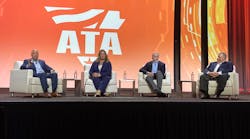NASHVILLE—When it comes down to it, business is good for commercial motor carriers. Even with supply chain problems, manufacturing is up, retail sales are high, and construction activity is strong. But equipment shortages and labor constraints aren’t projected to ease, causing companies to pivot in an environment quite unlike any other.
“We had 100% of new truck orders canceled in 2021,” Cari Baylor, president of Indiana-based Baylor Trucking, explained during American Trucking Associations’ 2021 Management Conference & Exhibition (MCE) here this week.
That, Baylor added, has caused capex and tax ramifications. She said the 75-year-old company typically keeps about 10% of equipment available for swaps and switches. Now, she said, Baylor Trucking reserves 12% to 15% of its equipment for those exchanges.
“It is like a Mr. Potato Head,” Baylor explained. “We are pulling our equipment and cannibalizing parts. We pre-bought parts and, over the past 90 days, we shipped out 57 parts to our partner dealerships. An OEM dealership doesn’t have the parts, so we are shipping it to our dealer locations to fix our equipment on the road.”
As a result, Baylor said equipment downtime is at the highest it has ever been, and the market is experiencing the highest used truck rates she’s ever seen.
Pilot Flying J, which has a fleet of about 1,400 trucks, also has an aging fleet and higher maintenance costs as a result of equipment shortages, CEO Shameek Konar noted during an MCE general session with Baylor, ATA Chief Economist Bob Costello, and US Bank SVP Jeffrey Pape. On the other side of the coin, Konar noted that business is good for Pilot, but keeping store shelves full for commercial driver customers is a struggle.
“Parcel is focused on that last mile, and a lot of our customers are seeking help in how they can make that last mile more efficient,” Pape said, noting fleets have been relying on analytics for more visibility into their maintenance and operations costs. “So, it’s really a mixed bag, but overall business is good in the commercial sector and government sector for us.”
Labor and wages
One of the bigger stories throughout the economy for ATA’s Costello is what’s happening in the U.S. labor market. Back in May throughout all sectors of the economy, nearly 600,000 net jobs were created. That jumped to nearly 1 million and then over 1 million in July, before taking a significant dip, according to Department of Labor data.
In August, the U.S. saw 366,000 net jobs created and then dropped to lower than 200,000 in September.
“Historically, that’s good, but it’s not good for right now,” Costello said, blaming the Delta variant as the main culprit.
“There are over 10 million job openings throughout the economy right now,” he added. “We’ve never seen anything like that. Yet, our labor force participation rate in the U.S. is decreasing.”
For long-haul general truckload freight, Costello said it’s not all about pay that's keeping people from the job. The average weekly pay earnings in the sector are five times more than the historical average since 2019.
“There are a lot of people out there who say it’s just all about pay and that’s it, but if we are going up at five times the historical average, then we should be seeing much more people joining this industry in this occupation,” Costello said.
Instead, employment in the long-haul truckload space has not increased at all.
“We’ve stopped the bleeding so far this year in the long-haul market, so it’s flat, but it’s not increasing,” Costello added. “If you look at local trucking jobs, they are going up. I am not going to tell you that all the folks in local trucking are getting all the drivers they need, but this screams to me quality of life, lifestyle, being at home.”
To improve the quality of life for its drivers, this year Baylor Trucking created more dedicated loops to provide at-home consistency and more semi-local opportunities. The company also implemented paid time off for professional drivers so they could take vacation time and get home more without having to worry about pay.
“And with shipper [detention] concerns we have to make sure that they have a weekly minimum they can count on,” Baylor stressed. “Innovation in pay and improving the quality of life are essential in retaining your drivers.”
For Pilot, Konar said even though most fleet drivers make it home every night, in the last three months, the company had periods where it had more than 20% open seats. Traditionally, Pilot would have roughly 1% to 2% of open seats to fill. Over the last three or four months, Pilot increased wages some 20% just to compete, Konar added.
Baylor also pointed out that quality of life for the over-the-road professional driver still is being impacted by the pandemic.
“Every day not only are they fighting labor and equipment issues, but they still can’t find good bathrooms,” she stressed. “Our shippers and receivers are still denying them restroom facilities. So, we tout them with pay and pride and as the superheroes of the highway, but they are still facing incredibly tough conditions. We have to implore our states, national agencies, our shippers and customers to take care of them like the superheroes they are.”
Baylor added that many drivers have rejected certain late runs because they want to get a shower in or grab a bite to eat before facilities that were once open late now close early due to labor shortages.
“One of our challenges is staffing,” Pilot’s Konar said. “There are places where we had to close restaurants overnight because of staffing issues. We had a goal of hiring 10,000 people this summer and retaining 7,000 of those people. We hired 21,000 people this summer, but we only retained 2,000. People were just cycling in and out.”
That has provided a challenge for truck stops and travel centers like Pilot to serve professional drivers the way they want.
This article originally appeared on FleetOwner.com.




